2020 SCTF 部分WriteUp
signin
准备
signin.exe:https://wwa.lanzous.com/inIQdec11zi

程序分析
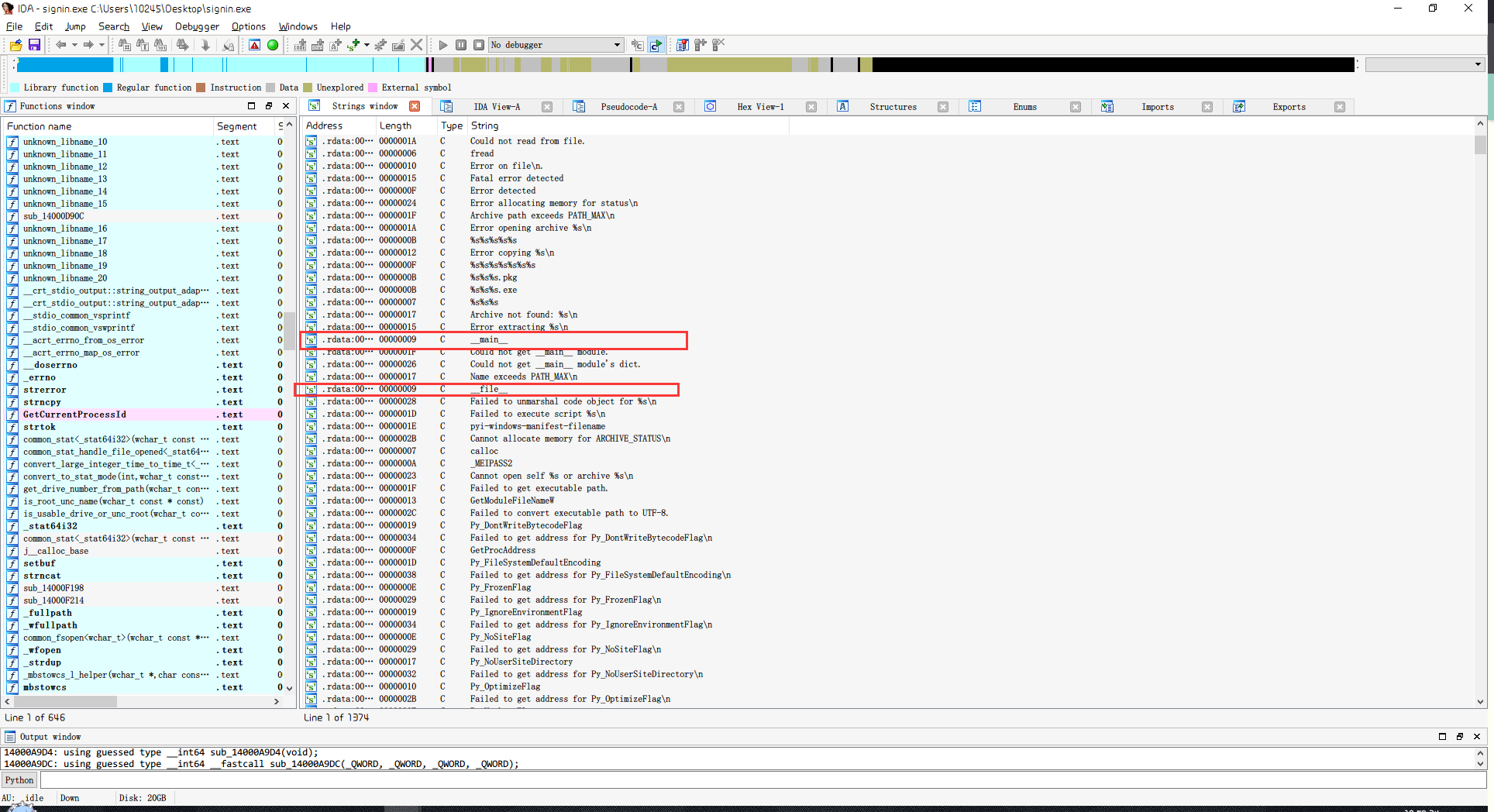
可以判断出,这个程序实际上是由Python打包成的可执行文件,且在运行这个程序时,在同目录下产生了一个tmp.dll文件,猜测是程序调用某些函数的接口。
反编译
使用archive_viewer.py反编译为字节码文件
python archive_viewer.py signin.exe
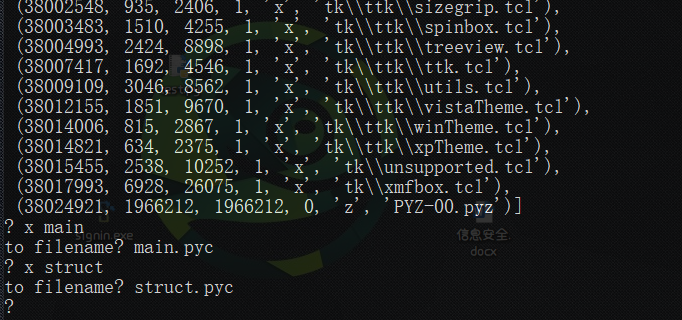
修补文件

55 0D 0D 0A 00 00 00 00 70 79 69 30 10 01 00 00

程序是在Python3.8环境下打包,因此我们需要在Python3.8下使用uncompyle6
uncompyle6 main.pyc > main.py
得到py文件
1 # uncompyle6 version 3.7.2 2 # Python bytecode 3.8 (3413) 3 # Decompiled from: Python 3.8.0 (tags/v3.8.0:fa919fd, Oct 14 2019, 19:37:50) [MSC v.1916 64 bit (AMD64)] 4 # Embedded file name: main.py 5 # Compiled at: 1995-09-28 00:18:56 6 # Size of source mod 2**32: 272 bytes 7 import sys 8 from PyQt5.QtCore import * 9 from PyQt5.QtWidgets import * 10 from signin import * 11 from mydata import strBase64 12 from ctypes import * 13 import _ctypes 14 from base64 import b64decode 15 import os 16 17 class AccountChecker: 18 19 def __init__(self): 20 self.dllname = './tmp.dll' 21 self.dll = self._AccountChecker__release_dll() 22 self.enc = self.dll.enc 23 self.enc.argtypes = (c_char_p, c_char_p, c_char_p, c_int) 24 self.enc.restype = c_int 25 self.accounts = {b'SCTFer': b64decode(b'PLHCu+fujfZmMOMLGHCyWWOq5H5HDN2R5nHnlV30Q0EA')} 26 self.try_times = 0 27 28 def __release_dll(self): 29 with open(self.dllname, 'wb') as (f): 30 f.write(b64decode(strBase64.encode('ascii'))) 31 return WinDLL(self.dllname) 32 33 def clean(self): 34 _ctypes.FreeLibrary(self.dll._handle) 35 if os.path.exists(self.dllname): 36 os.remove(self.dllname) 37 38 def _error(self, error_code): 39 errormsg = {0:'Unknown Error', 40 1:'Memory Error'} 41 QMessageBox.information(None, 'Error', errormsg[error_code], QMessageBox.Abort, QMessageBox.Abort) 42 sys.exit(1) 43 44 def __safe(self, username: bytes, password: bytes): 45 pwd_safe = b'\x00\x00\x00\x00\x00\x00\x00\x00\x00\x00\x00\x00\x00\x00\x00\x00\x00\x00\x00\x00\x00\x00\x00\x00\x00\x00\x00\x00\x00\x00\x00\x00\x00' 46 status = self.enc(username, password, pwd_safe, len(pwd_safe)) 47 return (pwd_safe, status) 48 49 def check(self, username, password): 50 self.try_times += 1 51 if username not in self.accounts: 52 return False 53 encrypted_pwd, status = self._AccountChecker__safe(username, password) 54 if status == 1: 55 self._AccountChecker__error(1) 56 if encrypted_pwd != self.accounts[username]: 57 return False 58 self.try_times -= 1 59 return True 60 61 62 class SignInWnd(QMainWindow, Ui_QWidget): 63 64 def __init__(self, checker, parent=None): 65 super().__init__(parent) 66 self.checker = checker 67 self.setupUi(self) 68 self.PB_signin.clicked.connect(self.on_confirm_button_clicked) 69 70 @pyqtSlot() 71 def on_confirm_button_clicked(self): 72 username = bytes((self.LE_usrname.text()), encoding='ascii') 73 password = bytes((self.LE_pwd.text()), encoding='ascii') 74 if username == b'' or password == b'': 75 self.check_input_msgbox() 76 else: 77 self.msgbox(self.checker.check(username, password)) 78 79 def check_input_msgbox(self): 80 QMessageBox.information(None, 'Error', 'Check Your Input!', QMessageBox.Ok, QMessageBox.Ok) 81 82 def msgbox(self, status): 83 msg_ex = {0:'', 84 1:'', 85 2:"It's no big deal, try again!", 86 3:'Useful information is in the binary, guess what?'} 87 msg = 'Succeeded! Flag is your password' if status else 'Failed to sign in\n' + msg_ex[(self.checker.try_times % 4)] 88 QMessageBox.information(None, 'SCTF2020', msg, QMessageBox.Ok, QMessageBox.Ok) 89 90 91 if __name__ == '__main__': 92 app = QApplication(sys.argv) 93 checker = AccountChecker() 94 sign_in_wnd = SignInWnd(checker) 95 sign_in_wnd.show() 96 app.exec() 97 checker.clean() 98 sys.exit() 99 # okay decompiling main.pyc
代码分析
通过代码我们能够了解到这些信息
1.
elf.dllname = './tmp.dll'
调用了tmp.dll文件作为接口。
2.
def __safe(self, username: bytes, password: bytes): pwd_safe = b'\x00\x00\x00\x00\x00\x00\x00\x00\x00\x00\x00\x00\x00\x00\x00\x00\x00\x00\x00\x00\x00\x00\x00\x00\x00\x00\x00\x00\x00\x00\x00\x00\x00' status = self.enc(username, password, pwd_safe, len(pwd_safe)) return (pwd_safe, status) def check(self, username, password): self.try_times += 1 if username not in self.accounts: return False encrypted_pwd, status = self._AccountChecker__safe(username, password) if status == 1: self._AccountChecker__error(1) if encrypted_pwd != self.accounts[username]: return False self.try_times -= 1 return True
self.accounts = {b'SCTFer': b64decode(b'PLHCu+fujfZmMOMLGHCyWWOq5H5HDN2R5nHnlV30Q0EA')}
调用tmp.dll文件中的enc函数,传入username, password, pwd_safe, len(pwd_safe),实际就是将password加密后存储到pwd_safe字节码中。最后用pwd_safe与b64decode(b'PLHCu+fujfZmMOMLGHCyWWOq5H5HDN2R5nHnlV30Q0EA')比较,且我们能够了解到用户名应该是SCTFer,且最后返回的status一个为非1。
打开tmp.dll文件,找到enc函数

观察代码,实际操作可以分为两部分,逆向分析
异或操作
第47~54行代码实际上就是将Dst与用户名循环异或,最后得到b64decode(b'PLHCu+fujfZmMOMLGHCyWWOq5H5HDN2R5nHnlV30Q0EA'),因此我们只需要逆向异或就能得到加密后的Dst
from base64 import * username = "SCTFer" pwd_safe = b64decode('PLHCu+fujfZmMOMLGHCyWWOq5H5HDN2R5nHnlV30Q0EA') # print (len(pwd_safe)) num = ["%02x" % x for x in pwd_safe] hex_num = [int(x, 16) for x in num] print(num) # print (len(num)) for i in range(32): hex_num[i] ^= ord(username[i % len(username)]) # print (hex_num) hex_nums = bytes.fromhex(''.join([hex(x)[2:].rjust(2, '0') for x in hex_num])) print (hex_nums)
得到
b'o\xf2\x96\xfd\x82\x9c\xde\xb52v\x86yK3\xe6\x1f\x06\xd8\xb7=\x13J\xb8\xe3\xb52\xb3\xd38\x86\x10\x02\x00'
加密操作
每次传入了8字节数据进行加密(总共64字节),打开sub_180011311函数
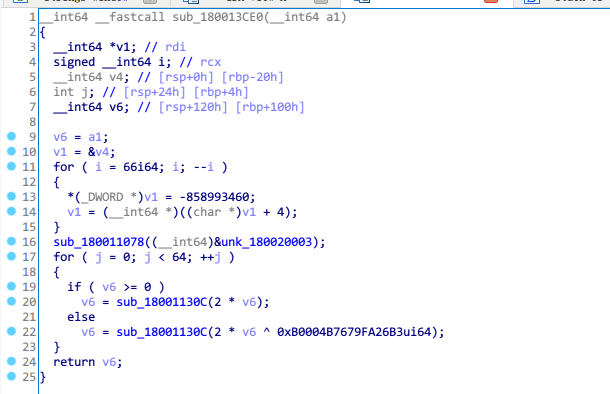
仔细观察代码,实际上这部分代码是使用CRC32的查表法,对数据进行加密。
加密原理实际上就是CRC32算法---输入一组长度32的字符串,每8个字节分为1组,共4组。对每一组取首位,判断正负。正值,左移一位;负值,左移一位,再异或0xB0004B7679FA26B3。重复判断操作64次,得到查表法所用的表。
因此我们只需要将整个加密过程逆向操作得到查表法的表,再进行CRC32计算,就能得到输入。
secret = [] # for i in range(4): # secret.append(int(hex_nums[i*8:(i + 1) * 8][::-1].hex(),16)) for i in range(4): secret.append(int.from_bytes(hex_nums[i*8:(i + 1) * 8], byteorder="little")) print (secret) key = 0xB0004B7679FA26B3 flag = "" for s in secret: for i in range(64): sign = s & 1 if sign == 1: s ^= key s //= 2 if sign == 1: s |= 0x8000000000000000 print(hex(s)) j = 0 while j < 8: flag += chr(s&0xFF) s >>= 8 j += 1 print(flag)
因为计算机中采用小端排序,因此需要注意分组倒序。得到

脚本
from base64 import * username = "SCTFer" pwd_safe = b64decode('PLHCu+fujfZmMOMLGHCyWWOq5H5HDN2R5nHnlV30Q0EA') # print (len(pwd_safe)) num = ["%02x" % x for x in pwd_safe] hex_num = [int(x, 16) for x in num] print(num) # print (len(num)) for i in range(32): hex_num[i] ^= ord(username[i % len(username)]) # print (hex_num) hex_nums = bytes.fromhex(''.join([hex(x)[2:].rjust(2, '0') for x in hex_num])) print (hex_nums) secret = [] # for i in range(4): # secret.append(int(hex_nums[i*8:(i + 1) * 8][::-1].hex(),16)) for i in range(4): secret.append(int.from_bytes(hex_nums[i*8:(i + 1) * 8], byteorder="little")) print (secret) key = 0xB0004B7679FA26B3 flag = "" for s in secret: for i in range(64): sign = s & 1 if sign == 1: s ^= key s //= 2 if sign == 1: s |= 0x8000000000000000 print(hex(s)) j = 0 while j < 8: flag += chr(s&0xFF) s >>= 8 j += 1 print(flag)
get flag!
username:SCTFer
password:SCTF{We1c0m3_To_Sctf_2020_re_!!}
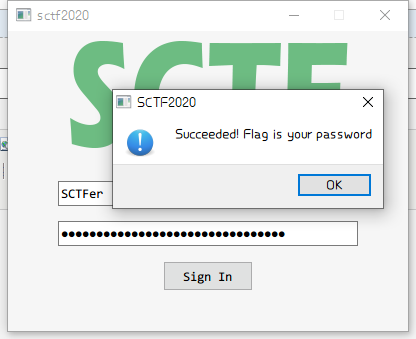
get_up
下载:https://wwa.lanzous.com/i6fDyedivgh
代码分析
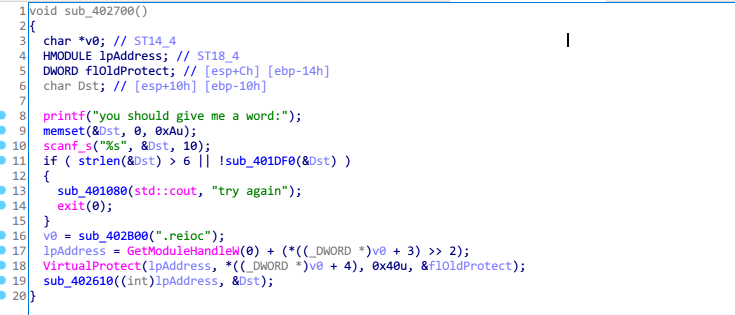
代码解析
beg_adr = 0x405000 dst = "sycsyc" for i in range(0,0x200,16): for j in range(16): PatchByte(beg_adr+i+j,Byte(beg_adr+i+j)^ord(dst[j%6]))
beg_adr = 0x404000 dst = "SCTF{" for i in range(16,96): PatchByte(beg_adr+i,Byte(beg_adr+i)^ord(dst[i%5]))
解密
#include<stdio.h> #include<stdlib.h> #include<string.h> typedef unsigned longULONG; #pragma warning(disable:4996) /*初始化函数*/ void rc4_init(unsigned char* s, unsigned char* key, unsigned long Len) { int i = 0, j = 0; char k[256] = { 0 }; unsigned char tmp = 0; for (i = 0; i < 256; i++) { s[i] = i; k[i] = key[i % Len]; } for (i = 0; i < 256; i++) { j = (j + s[i] + k[i]) % 256; tmp = s[i]; s[i] = s[j]; // 交换s[i]和s[j] s[j] = tmp; } } /*加解密*/ void rc4_crypt(unsigned char* s, unsigned char* Data, unsigned long Len) { int i = 0, j = 0, t = 0; unsigned long k = 0; unsigned char tmp; for (k = 0; k < Len; k++) { i = (i + 1) % 256; j = (j + s[i]) % 256; tmp = s[i]; s[i] = s[j]; // 交换s[x]和s[y] s[j] = tmp; t = (s[i] + s[j]) % 256; Data[k] ^= s[t]; } } int main() { unsigned char s[256] = { 0 }, s2[256] = { 0 }; // S-box char key[256] = { "syclover" }; char pData[512] = { 0 }; int v12[] = { 128,85,126,45,209,9,37,171,60,86,149,196,54,19,237,114,36,147,178,200,69,236,22,107,103,29,249,163,150,217 }; int i; //char m[32] = { 0 }; for (int i = 0; i < 30; ++i) { pData[i] = (char)v12[i]; } unsigned long len = strlen(pData); printf("pData=%s\n", pData); printf("key=%s,length=%d\n\n", key, strlen(key)); rc4_init(s, (unsigned char*)key, strlen(key)); // 已经完成了初始化 printf("完成对S[i]的初始化,如下:\n\n"); for (i = 0; i < 256; i++) { printf("%02X", s[i]); if (i && (i + 1) % 16 == 0)putchar('\n'); } printf("\n\n"); for (i = 0; i < 256; i++) // 用s2[i]暂时保留经过初始化的s[i],很重要的!!! { s2[i] = s[i]; } printf("已经初始化,现在解密:\n\n"); printf("len = %d\n", len); rc4_crypt(s, (unsigned char*)pData, len); printf("pData=%s\n\n", pData); system("PAUSE"); return 0; }

get flag!
SCTF{zzz~(|3[___]_rc4_5o_e4sy}
Can you hear
robot36 app:https://wwa.lanzous.com/it7Zsedix5i
音频是SSTV,用软件Robot36接受音频中的数据
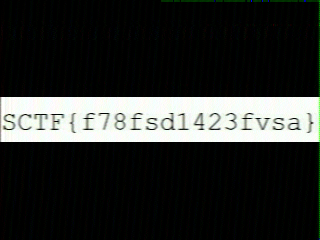
doudizhu
只要将手里牌出完,就能获得flag



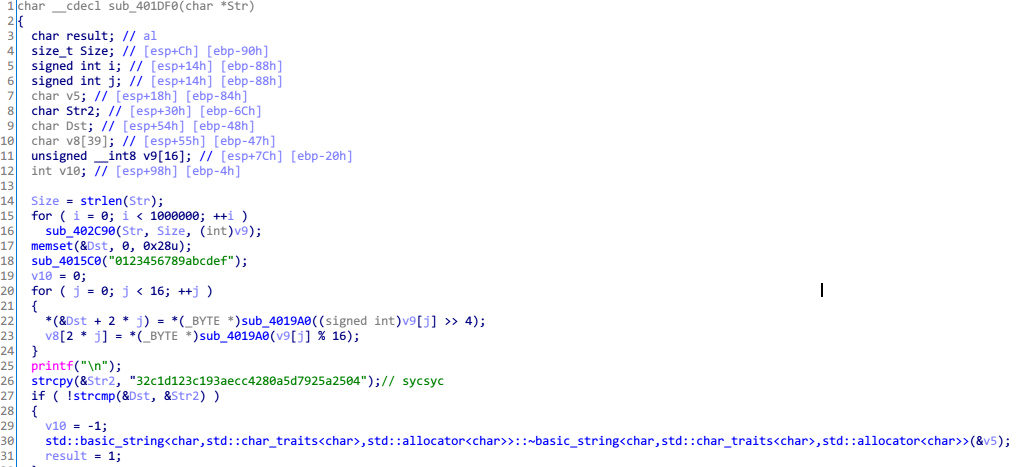


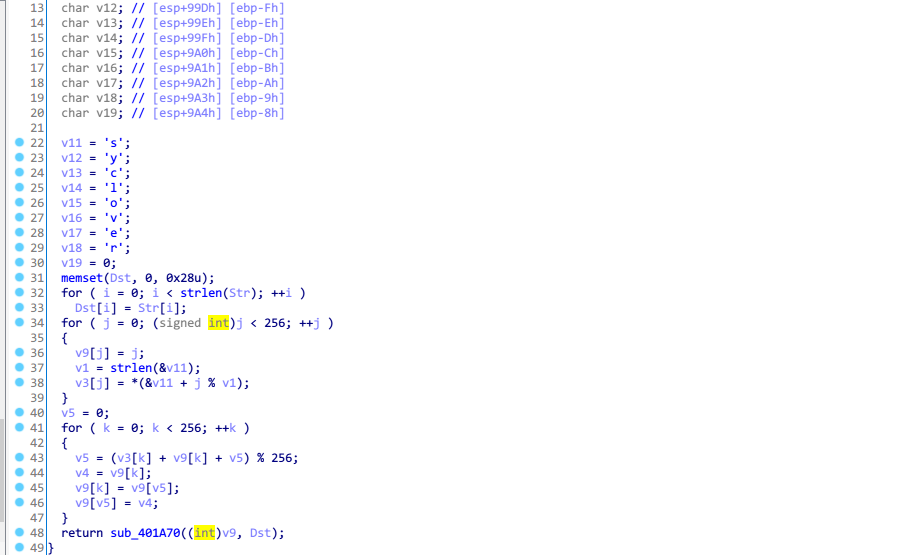

 浙公网安备 33010602011771号
浙公网安备 33010602011771号